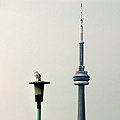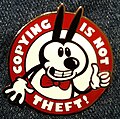Visual pun
Appearance
This article includes a list of references, related reading, or external links, but its sources remain unclear because it lacks inline citations. (September 2014) |

A visual pun is a pun involving an image or images (in addition to or instead of language), often based on a rebus.
Visual puns in which the image is at odds with the inscription are common in cartoons such as Lost Consonants or The Far Side as well as in Dutch gable stones. For instance the "Batenburg" stone from Prinsengracht, Amsterdam, shown here, puns on the words baten (to profit) and burg (castle) which together make up the name of a village near Nijmegen. European heraldry contains the technique of canting arms, which can be considered punning.
Examples
- In The Muppet Movie, while Kermit and Fozzie are driving. Kermit looks at the map and says they need to turn at the fork in the road. At this point he lowers the map and they see a giant fork (the cutlery) in the middle of the road.
- In Spaceballs, Dark Helmet tries to order his troops to comb the desert for his adversaries. The next scene depicts troopers with giant combs, literally combing the desert.
- In Super Mario Bros. and Super Mario Bros.: The Lost Levels, when Mario picks up a "fire flower", he becomes fiery. "Fire flower" in Japanese is literally 火花 (hi-bana; fire-flower), meaning spark, hence he is picking up a "spark".
- In Alice by Jan Švankmajer, there are a number of visual puns, including: socks in holes (socks crawling into and out of holes, punning on "holes in socks"); Alice opens a sardine can to reveal a key, punning on the key used to open a sardine can.
- In the 1976 version of The Omen, after speaking with Mr. Thorn (Gregory Peck), a nun steps into a paternoster lift - the name meaning "Our Father".
- The logo of the Chinese Lunar Exploration Program is a stylized 月 (Chinese character for "moon"), but is also a pair of human feet, surrounded by a crescent moon, symbolizing "walking on the moon".
Gallery
-
USAF squadron emblem shows a kicking donkey (an ass) with slogan "Kickin' Ass"
-
All is Vanity (1892) by C. Allan Gilbert (the table was called a vanity)
-
A lamppost (foreground) and Toronto's CN Tower (in distance)
-
"Copying is not theft!" badge with a character resembling Mickey Mouse is a visual pun on Mickey as a symbol of the whole intellectual property industry and its attitude towards copying.
-
A "mousetrap"
See also
Further reading
- Christian Hempelmann and Andrea C. Samson. “Visual Puns and Verbal Puns: Descriptive Analogy or False Analogy?” In: Diana Popa and Salvatore Attardo (Eds.), “New Approaches to the Linguistics of Humor.” Galati: Dunarea de Jos. 2007. 180-196.
External links
Wikimedia Commons has media related to Puns.
- princetonol.com
- So Much Pun, a collection of visual puns
- Another large collection of visual puns on TV Tropes






